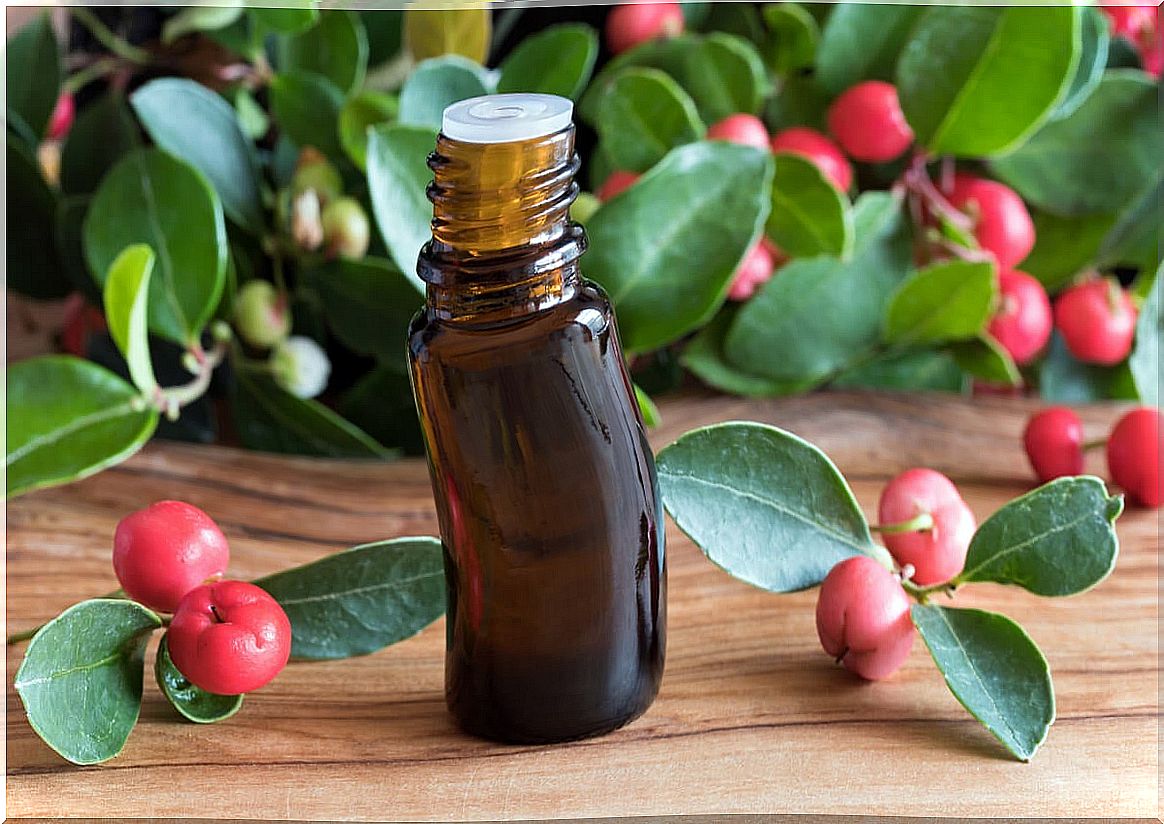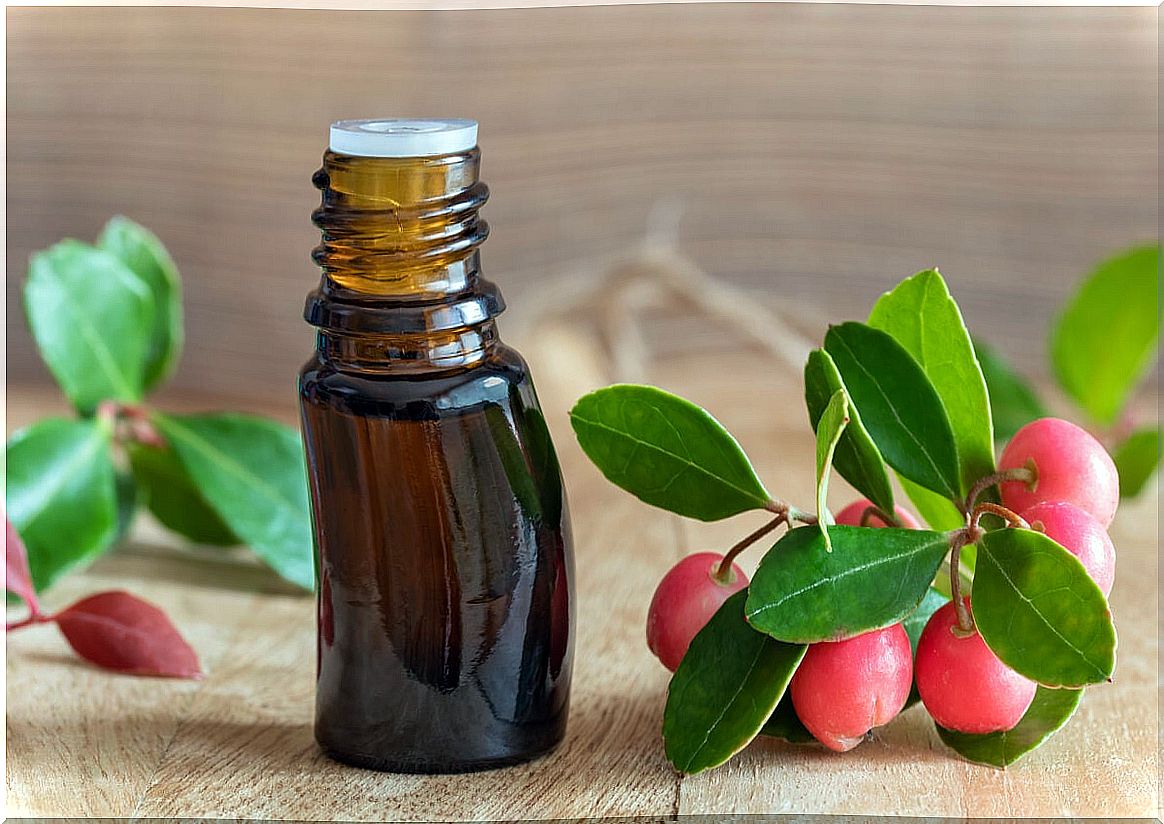What Is Wintergreen Essential Oil And What Are Its Uses?
Wintergreen essential oil is known for its anti-inflammatory and pain-relieving properties. It is usually used against muscle aches, headaches and other conditions. Keep reading!

Wintergreen essential oil has become popular for its pain-relieving effects. Although for now the evidence on its benefits is limited, there are studies that suggest that it reduces muscle strain, headaches and the presence of certain pathogenic bacteria.
On the other hand, it stands out for its clean and minty aroma that is used as a natural relaxant. Even so, it is a product that must be applied with caution, as in certain cases it is contraindicated. To learn more about it, we invite you to continue reading.
What is wintergreen essential oil and how is it obtained?
Wintergreen essential oil is a product obtained from the perennial shrub that bears the scientific name Gaultheria procumbens. It belongs to the Ericaceae family and is native to North American countries, such as the United States and Canada. It has a tall trunk, as well as oval green and white leaves, which later turn into edible red berries.
To make the essential oil, the leaves of the plant are collected and they go through a fermentation process. Once this is done, the distillation is continued to obtain a purer product. In the end, you get almost entirely methyl salicylate, which is its active ingredient.
Notably, production has now decreased as synthetic methyl salicylate is created. In fact, the latter appears among the ingredients of several types of oil, including commercial wintergreen oil or teaberry oil .
Composition of wintergreen oil
As an article in Molecules magazine explains , wintergreen oil is a source of bioactive phytochemicals that give it certain benefits. In particular, 80 to 90% corresponds to methyl salicylate, which is responsible for most of its properties. On the other hand, it contains the following:
- Procyanidins.
- Phenolic acids
- Chlorogenic acids.
- Flavonoids.

Wintergreen essential oil uses
In natural medicine, wintergreen essential oil has been used as an adjunct to treat various types of ailments. However, many of the properties attributed to it come from anecdotal data, that is, personal testimonies that have not been confirmed by science.
Anyway, some investigations have evaluated its properties and conclude that it has interesting pharmacological effects. What are its main uses and benefits?
Relief from pain and inflammation
The main active compound in wintergreen oil, methyl salicylate, has analgesic and anti-inflammatory properties that are used in the treatment of pain.
In fact, as explained in xPharm: The Comprehensive Pharmacology Reference, it is closely associated with aspirin, but is used topically, due to its irritating effect on the gastrointestinal mucosa.
Specifically, it is an adjuvant against muscle aches, headaches and tendonitis. A randomized controlled trial, published in Clinical Therapeutics , found that applying a patch containing methyl salicylate and menthol was helpful in relieving pain associated with mild muscle tension.
Meanwhile, a case study published in The Journal of ECT reported that topical application of methyl salicylate helped relieve headaches in a patient who had a severe headache after receiving electroconvulsive therapy. For now, more research is needed to corroborate these effects.
Insecticide
In popular culture, wintergreen essential oil is used as an insecticide or repellent. Even now it is in commercial presentations of these products.
In this regard, a study published in the Journal of Economic Entomology indicates that, compared to other essential oils, this product is more effective as an insecticide than as a repellent.
Antibacterial
Evidence on the antibacterial effects of wintergreen oil is limited. Despite this, research shared in Frontiers in Medicine reported that a 0.5% concentration of this oil exerted antibacterial activity similar – and even greater – than a control antibiotic against the Borrelia burgdorferi species that cause Lyme disease.
Aromatic
Industrially, this oil has been used as an agent to flavor products such as toothpastes, mouthwashes and candies, among others. According to a report by a subcommittee of the Food and Drug Administration (FDA), use in low concentrations, either alone or in combination with eucalyptus or menthol, is safe.
Risks and contraindications of wintergreen essential oil
The general recommendation is to use wintergreen essential oil with caution. Methyl salicylate can be toxic, especially when used in excessive amounts.
Symptoms of poisoning with this substance are as follows:
- Nausea or vomiting
- Rapid breathing (hyperventilation)
- Sweating
- Muscle spasms.
- Ringing in the ears
- Seizures (severe cases)
- Coma (severe cases).
On the other hand, the composition of this ingredient increases the effects of anticoagulant drugs. Consequently, it can lead to bleeding and associated complications.
Both wintergreen oil and any product with methyl salicylate is contraindicated in the following cases:
- Kids.
- Pregnant or lactating women.
- People who take blood thinners.
- Patients with a bleeding disorder, such as hemophilia.
- Allergic to aspirin.

How is wintergreen essential oil used?
It is convenient to remember that this essential oil is only used externally, since it is very strong and irritates the gastric mucosa. For its application on the skin it is necessary to combine it with a carrier oil, such as coconut, grape seed or jojoba oil.
According to information from the New York Institute for Aromatic Studies, wintergreen oil should represent only between 2 and 3% of the final volume of the preparation. For this reason, it is advisable to add only 10 to 15 drops of the product in each fluid ounce of carrier oil.
What to remember about wintergreen essential oil?
In folk medicine, wintergreen essential oil is a natural supplement to reduce pain and inflammation. However, its use is not indicated as a first-line approach.
It must be borne in mind that the evidence for its safety and efficacy is still limited; therefore, it should be used with caution, only in specific cases.









